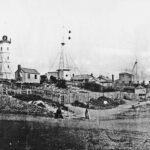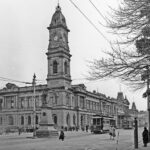Time controls our daily activities; we sell our labour by the hour, we arrange meetings and synchronise with others by the clock, we use timetables to make sure we are on time to catch the train, bus or plane. Time is the measure by which we regulate our lives, and in the past navigators needed accurate time to determine their longitude.
The Day
The passage of the sun and stars across the sky has long been used to mark time. Noon was set when the sun passed directly overhead. The time between two successive noons is the apparent solar day. But the earth’s elliptical orbit around the sun causes days to be of slightly different lengths. So an average length of day (mean solar day), divided into twenty four equal hours, is used for time-keeping. This is the time our clocks show – ‘clock time’.
Synchronising Time
Within a year of settlement, Adelaide’s residents were synchronising their timepieces by a bell rung in North Terrace near West Terrace at local noon. It was replaced by a gun fired on Saturday near the flagstaff on the corner of West Terrace and Franklin Street. In late 1853 the gun was moved to the Police Barracks on North Terrace and fired daily. Following complaints from residents, the gun was silenced in 1882. The General Post Office (GPO) clock had been installed in 1876 and became the standard by which Adelaide’s timepieces were set.
Time Zones
Local noon in a neighbouring community east or west can differ by seconds or minutes. This mattered little when travel and communications were limited to the slow speed of the horse. But it was inconvenient for rapid long-distance travel by railway or instantaneous communication by telegraph, both introduced into South Australia during the 1850s. In 1887 the railway from Adelaide connected with the railway from Melbourne near Bordertown., Local time here was 10 minutes ahead of Adelaide and 15 minutes behind Melbourne. South Australian timetables were kept in Adelaide time, nine hours fourteen-and-a-half minutes ahead of Greenwich. This was the local time of the Adelaide Observatory on West Terrace. In 1894 the Colonial Astronomers agreed to adopt Dowd’s time zone system, which kept clock-noon near sun-noon. Australia was divided into three time zones: Western Australia eight hours ahead of Greenwich, South Australia nine hours and eastern Australia ten hours.
Standard Time
The Standard Time Act (1894) set South Australian standard time at nine hours ahead of Greenwich. On Friday 1 February 1895 clocks were turned back fourteen-and-a-half minutes. At the Victorian border the time difference between the neighbouring colonies increased from 25 minutes to 60 because Victorian clocks were advanced 20 minutes. A new timetable had to be prepared for the Intercolonial Express between Adelaide and Melbourne.
This new standard time was unpopular. South Australian businesses were disadvantaged because local telegraph offices opened an hour later than the eastern colonies. Cables from Britain had already passed through South Australia over the Overland Telegraph yet were unavailable locally until nine am. Furthermore for two hours each day no intercolonial business could be transacted. By advancing clocks 30 minutes, these disadvantages would be reduced, the working class would not have to labour under gaslight, and football matches would not have to end in the dark. The Standard Time Act (1898) redefined standard time as nine-and-a-half hours ahead of Greenwich. On Monday 1 May 1899 South Australian clocks were advanced half an hour. South Australia became one of the few jurisdictions in the world with a time zone differing by part of an hour from Greenwich. Subsequent proposals to remove this half hour time difference by adopting Eastern Standard Time all year for South Australia have been unpopular.
Daylight Saving
Daylight saving was trialled in 1917 during the First World War. Clocks were advanced one hour for five months during summer to make better use of the longer daylight hours. This trial was not repeated until 1942–44 during the Second World War. It was permanently adopted in October 1972 amid claims that the extra hour of sunshine would fade the curtains and put hens off the lay.
Determining Longitude
Until recently navigators and surveyors needed to know Greenwich time accurately to determine their longitude. The New South Wales Governor (Gipps) sent surveyor CJ Tyers to the mouth of the Glenelg River in December 1839 to mark the 141st meridian of longitude forming the South Australia–New South Wales (South Australia–Victoria from 1850) border. He fixed it two miles west of its correct location because his chronometer was in error. Better knowledge of Greenwich time made possible by the Adelaide–Sydney telegraph enabled Charles Todd to accurately fix the South Australia–New South Wales border in 1868.
Time Signals
To enable navigators to set their chronometers, a time ball was erected at Semaphore, commencing operation on 2 August 1875. The ball was dropped at one pm daily, being triggered by a telegraph signal from the observatory on West Terrace. Another time ball at Port Adelaide on top of the Harbors Board Office in Lipson Street commenced operation on 1 November 1920. Due to the increasing use of wireless telegraphy time signals, both time balls ceased operation on 1 February 1932. Since the 1980s surveyors have used the satellite-based Global Positioning System to determine exact location. It has its own accurate time signals.







Comments
4 responses to “Time”
Looking for information on the time ball atop the GPO. It can be seen in photos as late as 1952. Cheers Chris
Hi Chris, I don’t know about a time ball I’m afraid, but there’s detail on the building structure, and a bibliography for more, in the Australian Heritage Database – http://www.environment.gov.au/cgi-bin/ahdb/search.pl?mode=place_detail;s…
If you’re looking to really dig for information I’d start with the file series D5440 at the National Archives of Australia – https://recordsearch.naa.gov.au/SearchNRetrieve/Interface/SearchScreens/…
Hello Chris! The timeanddate.com website states in its history of the Adelaide timezone that the original local time was UTC+9 hours 14 mins 20.4 seconds, but above it is stated as UTC +9 hours 14 mins 30 seconds. What is your source?
Newspaper article of 31st Jan 1895 states the 20.4 figure. However I note that if you convert UTC +9 hours 14 mins 30 seconds to longitude you get 138.5604 East, which is quite close to West Tce Longitude where the observatory was.
Hi Chris,
I’ll have to see if we can track down where the author got that detail, his sources are listed above but I’ll need to go through them for any specific reference to this point. I’ll go through what we have on file and see who we can reach out to on this.